It is essential that a steam engine be placed upon a solid, unyielding foundation. It is unwise to pay for a good machine and then set it upon a foundation that will yield to the weight and working strains in such a way as to throw the parts out of line, bringing about injurious wear and derangement.
Large cut stones make the most solid foundation, but these are costly; hard-burned brick make an excellent substitute. These should be laid in cement, with thin joints. No stones are required except the cope-stone, which should be cemented to the brick-work.
The drawings furnished by engine builders will give the necessary width and depth of foundation, assuming that the bottom rests on solid ground. If this is not reached at the depth indicated, the excavation should be deeper, the bottom rammed hard and filled up to the point at which the foundation proper is to begin with rough stones laid in cement.
Note.—
Concrete made mixing five parts broken stone, two parts clean sharp sand and one part Portland cement makes a very satisfactory foundation. The foundation should be completed at least fifteen days before the engine is placed on it, by which time, if properly laid, the brick-work will be practically one mass.
The accompanying illustrations show three different shapes of foundations.
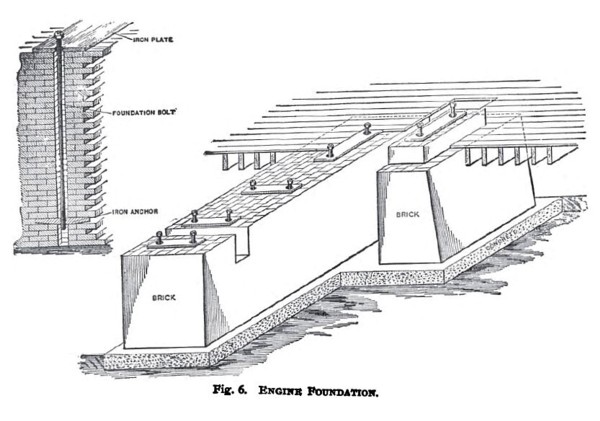 Engine Foundations |
Fig. 6 is the form used for girder frame engines, as the Corliss engine generally is built.
A layer of concrete is first spread over the bottom of the excavation, on top of which the brick-work is laid. The fastening of the anchor bolts is shown in Fig. 6, consisting of a heavy cast-iron plate, laid in the brick-work, and drilled and threaded for the bolt; the top is formed of cast-iron plates, on which the pedestals rest.
The bottom plates need not be threaded, but simply drilled, to allow the bolt to pass through, and by allowing an opening to be left in the brick-work underneath the plates, a nut may be screwed to the end of the bolt. Cope stones can take the place of the top plates in either case.
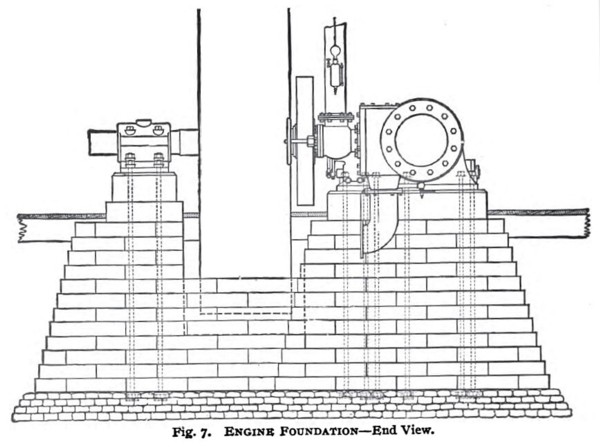 Engine Foundation-End View |
Fig. 7 shows a form of foundation which differs from the first described by a brace being run across, combining the outboard pillow block part with the main body of the foundation, and the bolts being masoned into the brickwork, the foot ends passing through a broad washer.
This foundation is generally used for tangeye bed engines, which usually run at medium speed. The foundation used for high speed self-contained engines is shown in Fig. 8; it simply consists of a solid body of brick-work.
Note.—
Foundation bolts should be held in position by a wooden template with bolt holes corresponding to those in the engine base. It is better not to build the foundation solidly around the bolts, except at the extreme bottom. Space should be left around each bolt, increasing toward the top, so that at its upper end the bolt has a play of one or two inches. It is very often the case that a timber foundation is found to be the best, or indeed, the only practicable foundation for an engine or for a heavy machine. The number of semi-portable steam engines used to run dynamos during engineering work of more or less duration, makes it desirable to have a method of holding the machine down, which will permit of "pulling up stakes" on short notice and settling again promptly at a greater or less distance. In such cases, heavy beams may be used for bed timbers, and to these the engine held down by bolts, or, indeed, by long lag screws; in all cases the thread and bearing surfaces of heads, washers, etc., being smeared with grease and graphite (black lead) before running up.
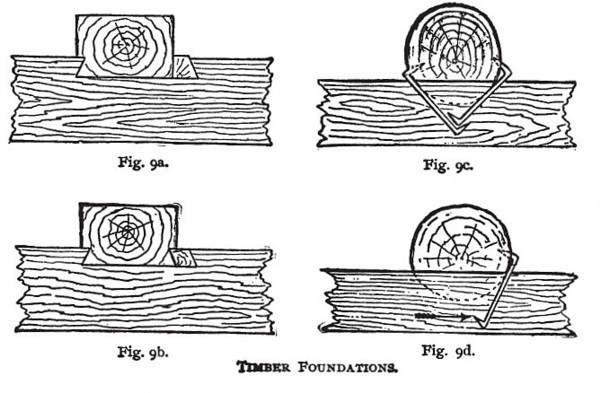 Timber Foundations |
The lengthwise timbers to which the engine is bolted may very easily be secured to heavy cross timbers (to give both weight and lateral rigidity) by dovetail wedges of yellow pine, as shown in Figs. 9a and 9b. In Fig. 9a only one edge of the lengthwise balk is dovetailed, and the wedges alone the other side have one flat bearing side.
In Fig. 9b both sides of the lengthwise timbers are dovetailed, and the wedges are cut to correspond. Where the wedges have one vertical face in contact with the lengthwise beam, as in Fig. 9a, they should have more vertical bearing surface, as there indicated.
Such a frame may be locked together in short order, and dismantled quickly and without injury to the timbers. When in service it may be weighted down by rocks or odd castings, or similarly wedged to lengthwise timbers parallel to those on which the engine rests.
Timber foundations may also be fastened together by dogs of this outline:
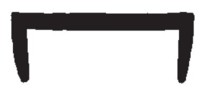 Spike Dog |
This mode is not so bad where round logs are used for the heavy cross-pieces; but when dogs are used care should be taken that they always run obliquely across the intersection of two timbers and never parallel with either of those which they join. This applies the “diagonal brace” principle. If this is neglected the structure, if the under timbers are round and lie crosswise of the cylinder-bore, will very promptly work itself to pieces; and in any case, for every dog that leans in one direction there must be another which leans in the opposite direction.
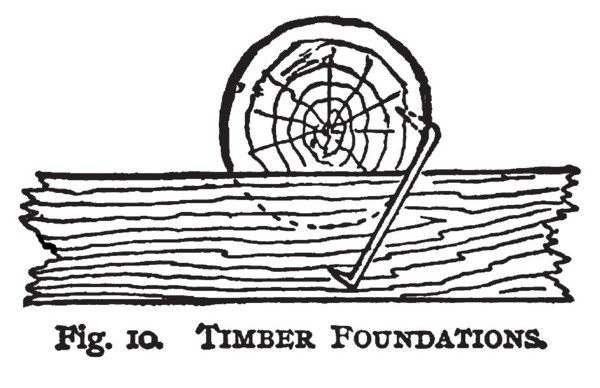 Timber Foundations |
The reason for this is seen in Figs. 9d and 10. The dog shown in Fig. 10 does not properly resist & lengthwise thrust from right to left, as shown by the arrow in Fig. 9d. Where, however, as shown in Fig. 9c, each dog has another one opposed to it, the hinge business is effectually done away with. dogs are only desirable where round timbers are used, as these afford less wedging surface than square ones.
Information Sources
- New catechism of the steam engine 1902 pages 31-38